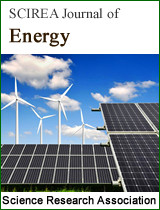Performance parameter analysis of thermoelectric generators for power generation system from the scramjet cooling heat
DOI: 10.54647/energy48117 91 Downloads 228961 Views
Author(s)
Abstract
Thermoelectric generator (TEG) for power generation system is proposed for energy recovery. The heat from cooling scramjet would be converted to electric energy. A parametric study of TEGs power generation system for heat recovery has been performed. The output power, the efficiency and the fuel flow saving ratio of the system have been analyzed and the proposed heat transfer analysis method of the system is depicted. Numerical results indicate that the total output power, the efficiency and the fuel flow saving ratio increase with the increase of fuel coolant flow rate. Most important, valuable amount of output power can be drawn by employing TEGs power generation system for hypersonic vehicles powered by scramjet.
Keywords
Energy recovery, Scramjet, TEG, Output power, Fuel coolant
Cite this paper
Xinchun Li, Zhongwei Wang, Liang Zhang,
Performance parameter analysis of thermoelectric generators for power generation system from the scramjet cooling heat
, SCIREA Journal of Energy.
Volume 6, Issue 4, August 2021 | PP. 54-68.
10.54647/energy48117
References
| [ 1 ] | J. Chang, W. Bao, D.R. Yu, Hypersonic inlet control with pulse periodic energy addition, J. Aerospace Eng. 223 (2009) 85-94. |
| [ 2 ] | D. Mahapatra, G. Jagadeesh, Shock tunnel studies on cowl/ramp shock interactions in a generic scramjet inlet, J. Aerospace Eng. 222 (2008) 1183-91. |
| [ 3 ] | K. Kontis, Flow control effectiveness of jets, strakes, and flares at hypersonic speeds, J. Aerospace Eng. 222 (2008) 585-603. |
| [ 4 ] | T. Thompson, D. Weeks, The DARPA/USAF falcon program update and the spaceX maiden launch, AIAA. 2007-9912. |
| [ 5 ] | W. Bao, J. Qin, D.R. Yu, Integrated thermal management method of energy based on Closed Brayton Cycle for scramjet, in: Proceedings of the 42nd AIAA/ASME/SAE/ASEE Joint Propulsion Conference. 9-12 July 2006, Sacramento, California, 2006. |
| [ 6 ] | C. Carpenter, S. Verma, J.S. Kapat, Numerical study of enhancement of regenerative cooling using ribs, in: Proceedings of the 49th AIAA/ASME/SAE/ASEE Joint Propulsion Conference. 14-17 July 2013, San Jose, CA, 2013. |
| [ 7 ] | N. Gascoin, P. Gillard, E. Dufour, Y. Toure, Validation of transient cooling modeling for hypersonic application, J. Thermophys Heat Tr. 21 (2007) 86-94. |
| [ 8 ] | J. Chang, W. Bao, Effects of wall cooling on performance parameters of hypersonic inlets, Acta Astronaut .65( 2009) 467-76. |
| [ 9 ] | Y. Tsujikawa, G. Northam, Effects of hydrogen active cooling on scramjet engine performance, INT. J. Hydrogen Energ. 21 (1996) 299-304. |
| [ 10 ] | J. Qin, W. Bao, W.X. Zhou, D.R. Yu, Performance cycle analysis of an open cooling cycle for scramjet, J. Aerospace Eng. 223 (2009) 599-607. |
| [ 11 ] | W. Bao, J. Qin, W.X. Zhou, D.R. Yu, Parametric performance analysis of multiple re-cooled cycle for hydrogen fueled scramjet, INT. J. Hydrogen Energ. 34 (2009) 7334-41. |
| [ 12 ] | W. Bao, J. Qin, W.X. Zhou, D. Zhang, D.R. Yu, Power generation and heat sink improvement characteristics of recooling cycle for thermal cracked hydrocarbon fueled scramjet, Sci China Technol Sci. 54 (2011) 955-63. |
| [ 13 ] | W. Bao, D. Zhang, J. Qin, W.X. Zhou, Performance analysis on fuel turbo-pump and motor system of scramjet engine, in: Proceedings of the 10th International Energy Conversion Engineering Conference. 30 July - 01 August 2012, Atlanta, Georgia, 2012. |
| [ 14 ] | Z.B. Tang, Y.D. Deng, C.Q. Su, A research on thermoelectric generator's electrical performance under temperature mismatch conditions for automotive waste heat recovery system, Case Studies Thermal Eng. 5 (2015) 143-150. |
| [ 15 ] | R. Ahiska, S. Dislitas, Computer controlled test system for measuring the parameters of the real thermoelectric module, Energ Convers Manage. 52 (2011) 27-36. |
| [ 16 ] | Q. Yang, J. Chang, W. Bao, Thermodynamic analysis on specific thrust of the hydrocarbon fueled scramjet, Energy. 76 (2014) 552-8. |
| [ 17 ] | F. Meng, L.G. Chen, F. Sun, A numerical model and comparative investigation of a thermoelectric generator with multi-irreversibilities, Energy. 36 (2011) 3513-22. |
| [ 18 ] | B. Yilbas, A. Sahin, Thermoelectric device and optimum external load parameter and slenderness ratio, Energy. 35 (2010) 5380-4. |
| [ 19 ] | A. Sahin, B. Yilbas, S. Shuja, O. Momin, Investigation into topping cycle: thermal efficiency with and without presence of thermoelectric generator, Energy. 36 (2011) 4048-54. |
| [ 20 ] | Q. Du, H. Diao, Z. Niu, G. Zhang, G. Shu, K. Jiao, Effect of cooling design on the characteristics and performance of thermoelectric generator used for internal combustion engine, Energ Convers Manage. 101 (2015) 9-18. |
| [ 21 ] | B. In, H., Kim J. Son, K. Lee, The study of a thermoelectric generator with various thermal conditions of exhaust gas from a diesel engine, INT. J. Heat Mass Tran. 86 (2015) 667–680. |
| [ 22 ] | G.Q. Shu, J. Zhao, H. Tian, X.Y. Liang, H.Q. Wei, Parametric and exergetic analysis of waste heat recovery system based on thermoelectric generator and organic rankine cycle utilizing R123, Energy. 45 (2012) 806-816. |
| [ 23 ] | M. Jon, D. Frederick, S. Alp, Si/Ge–WSi2 composites: Processing and thermoelectric properties, Acta Mater. 98 (2015) 263-274. |

